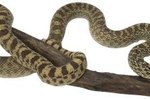It's called "polycephaly," and although featured in myths ranging from a three-headed dog to a seven-headed hydra, multiheaded animals are not only living, but, in some cases, are actually thriving. Of these, perhaps the most adept at surviving this usually fatal trait are domestic snakes, kept as pets.
Two for the Price of One
Two-headed snakes, despite their unexpected appearance, aren't some herald of a doomsday prophecy. Instead, this slithery anomaly, which can happen in any species of snake, is simply the result of twins that didn't fully divide as embryos. Their lack of foresight while procrastinating their --admittedly, uncontrollable -- separation means that each snake has his own animal instincts, incentives and biological drive, but is confined to relinquishing control now and again to their sibling. Forever. And you thought being stuck in the backseat of your parent's car was bad.
A Captive Audience
It would seem that captivity does wonders for these unique reptiles, namely keeping them alive. The chances of any animal with multiple heads surviving in the wild are slim; without proper care and guidance, the heads of polycephalic animals tend to disagree, disorient and even violently war with one another.
In a tank, however, two-headed snakes have limited directions to argue over, and feeding time is a carefully monitored activity. Hungry snake heads have the propensity to hunt one another, apparently not considering the logical outcome of winning. After their dinner, which always is served to both at the same time, even if one head has no appetite, the individual heads must be wiped clean to prevent late night munchies on their sibling.
By scheduling a consistent feeding time, the snakes eventually become accustomed to eating together. This might not inspire fraternal love, but it will focus their attention on their own food; until one of them finishes their meal, that is. If the two heads are not divided by a physical barrier during feeding, the head that finishes first will try to take the remaining food from the slower snake.
Positive Prognosis
Healthy -- aside from, you know, the extra head -- two-headed snakes raised by practiced owners in captivity can live just as long as their single-headed counterparts, and some can even procreate. The oldest two-headed snake on record lived to be nearly 20 years of age; possibly due to its relative independence compared to other two-headed snakes. This particular black rat snake sported not only two distinct heads, but also two separate throats and stomachs. Apparently when it comes to sharing a body, snakes that put their heads together don't stand more of a chance.





